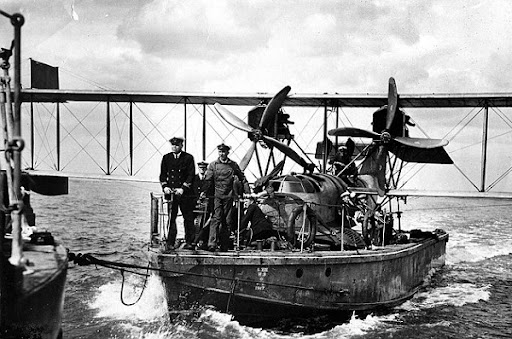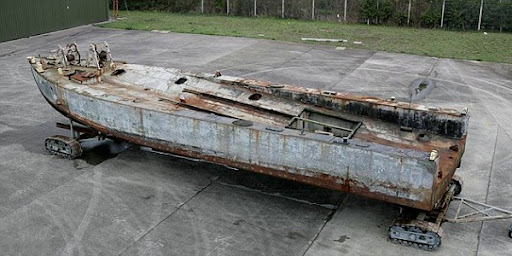The BBC reports that the dilapidated wreckage of a World War I seaplane lighter has been discovered in England.
A 1918 Thorneycroft Seaplane Lighter was discovered in the River Thames by a maritime journalist who saw a rusting hull sticking out the water.
A Thorneycroft Seaplane Lighter during World War I,
carrying what appears to be a Felixstowe F.2 seaplaneMuseum director Graham Mottram said he was astonished at the discovery.
“I was well aware of the story of these seaplane lighters, but was astonished to find that one had survived intact,” he said.
“My short walk along the deck was some of the most exciting steps I have ever taken!”
Another Thorneycroft Seaplane Lighter during World War I,
this one carrying what appears to be
a Sopwith Pup fighter of the Royal Naval Air ServiceAfter seeing the aircraft carrier for himself, he immediately arranged for it to be carefully lifted from the water and transported to the museum’s restoration hanger.
Restoration of the seaplane lighter has revealed many of the craft’s original features.
Details including the original Boat Number H21 along with the Ministry of Defence’s required details of craft length LVIII (58ft) and the War Department’s broad-arrow symbol.
Other interesting details are the original crew quarters in the bow.
There’s more at the link.
To call a seaplane lighter an ‘aircraft carrier’ is stretching the truth, I’m afraid . . . but I guess that’s what journalists do best! Nevertheless, this vessel is a very interesting historical artifact. Seaplane lighters had no engines of their own. They were designed to be towed behind fast destroyers, to allow seaplanes to accompany larger ships and fly ahead of them to perform reconnaissance duties or even attack enemy vessels. The aircraft would return, land on the water, then be winched aboard using the inclined ramp at the stern of the lighter (visible in the last photograph above – it would extend into the water when the lighter was afloat).
The seaplane lighters were also used to ferry smaller aircraft across the Channel (as in the second photograph above), and to carry urgently needed supplies. They could be towed behind fast ships like destroyers, then left in French ports to be unloaded at leisure before being taken back to England for another load. This avoided detaining the warships themselves in harbor to be unloaded, freeing them to perform other missions.
Once restored, the seaplane lighter will be on display in the Fleet Air Arm Museum.
Peter



Greetings from Texas,
I had never heard of these, but it's fantastic. I would love to get some more detail photos of it.
Are these of the same type that was used afor the Schneider Trophy racers down in the Solent, or were they of a smaller type? These looks bigger judged from images I've seen..